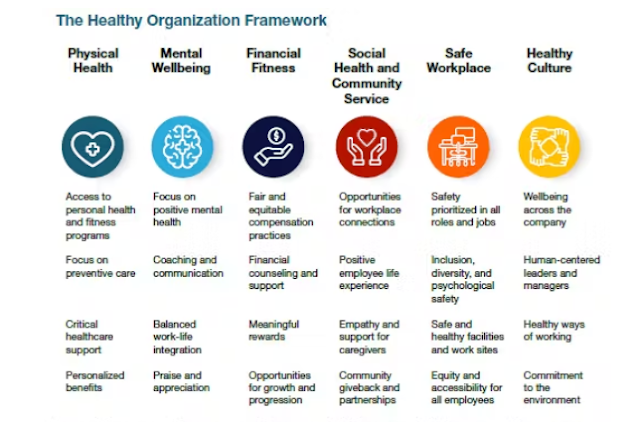Empowering Minds: How Prioritizing Employee Wellness and Mental Health Boosts Workplace Success
How Prioritizing Employee Wellness and Mental Health Boosts Workplace Success
August 10
 |
| Figure 01-How Prioritizing Employee Wellness and Mental Health Boosts Workplace Success |
Introduction
The significance of employee wellbeing and mental health in today's fast-paced, frequently high-pressure work environment cannot be understated. Organisations are realising more and more that a healthy staff is essential to success as they aim for peak performance and long-term growth. The book "Empowering Minds: How Prioritising Employee Wellness and Mental Health Boosts Workplace Success" explores the reasons why making mental health investments is advantageous from a strategic and moral standpoint.
The Relationship Between Performance and Well-Being
Establishing a Friendly Environment
Open Discussion and Awareness - Promoting open discussions about mental health issues helps in alleviating these problems. Providing mental health resources on a regular basis and fostering an environment where workers feel at ease talking about concerns are crucial. Workshops, training sessions, and awareness campaigns can all help with this.
Providing Resources - Giving staff members access to mental health resources, like counselling services, Employee Assistance Programs (EAPs), and methods for dealing with stress, demonstrates to them that their wellbeing is their number one priority. The secret to these materials' success is making sure they are secure .
Adaptable Work Schedules - Work-life balance can be greatly enhanced and stress levels can be considerably lowered with flexible scheduling and remote work possibilities. Providing these choices enables workers to better balance their personal and work obligations, which increases job satisfaction and decreases stress.
Encouraging a Balanced Work-Life - It is essential to motivate staff members to take regular breaks, make use of their vacation time, and keep boundaries between their personal and professional lives. Work-life balance-promoting policies can be put into place by organisations, and leaders can set an example of these behaviours.
 |
| Figure 02- Framework of the healthy organization |
The Advantages of Placing Mental Health First
- Increased Productivity
- Decreased Turnover and Absenteeism
- Enhanced Organisational Culture:
- Developing and Managing Talent
Conclusion
It's necessary to recognise the important impact that wellness and mental health programs have on workplace success in addition to satisfying modern expectations when implementing them into organisational procedures. Organisations can develop a resilient, engaged, and productive workforce that propels long-term success by making improvements in the mental health of their workforce. Those who put employee wellness first and actively promote it will be in a strong position to lead in both productivity and employee happiness as the business environment changes. Making mental health a top priority is a strategic advantage that helps everyone, from individual workers to the company as a whole.
References
Available at: https://www.youtube.com/watch?v=Umq8e0ivm0s&t=195s
[Accessed 09 August 2024].
Available at: https://www.microsoft.com/en-us/microsoft-viva/employee-wellbeing
[Accessed 09 August 2024].
Good article
ReplyDeleteYour blog highlights a crucial aspect of modern organizational success. Emphasizing wellness and mental health is not just a response to contemporary expectations but a strategic investment in a company's future. By integrating robust mental health programs, organizations not only enhance individual well-being but also foster a more engaged and resilient workforce. This holistic approach can significantly boost both productivity and employee satisfaction, positioning companies to thrive in an evolving business landscape. Prioritizing mental health is indeed a forward-thinking strategy that benefits both employees and the overall success of the organization.
ReplyDeleteThe blog discusses the importance of prioritizing well-being and mental health in modern organizations. It suggests that implementing robust mental health programs is a strategic investment in a company's future, improving individual well-being and creating a more engaged and resilient workforce. This comprehensive approach can lead to increased productivity and employee satisfaction, helping businesses succeed in a changing business environment. Prioritizing mental health is considered a progressive strategy that benefits employees and the overall success of the organization.
ReplyDeleteThis blog beautifully highlights the critical importance of prioritizing mental health and wellness in the workplace. It's a powerful reminder that when companies invest in their employees' well-being, everyone benefits, creating a more productive and happier work environment.
ReplyDeleteThe blog emphasises the significance of prioritizing well-being and mental health in contemporary organizations. It proposes that investing in strong mental health programs is a strategic move for a company's future, enhancing individual well-being while fostering a more engaged and resilient workforce. This holistic approach can boost productivity and employee satisfaction, positioning businesses for success in a dynamic business environment. Emphasizing mental health is seen as a forward-thinking strategy that benefits both employees and the organization’s overall success
ReplyDeleteMental health not only enhances the overall quality of life for employees but also has a direct impact on cognitive performance. Great.
ReplyDeleteThe crucial role of employee well-being in achieving organizational success is well outlined. By focusing on employee well-being, organizations not only improve individual health but also drive collective success and long-term growth.
ReplyDeleteBy taking proactive measures to support mental health, firms may increase output, lower attrition, and improve overall work satisfaction.
ReplyDelete